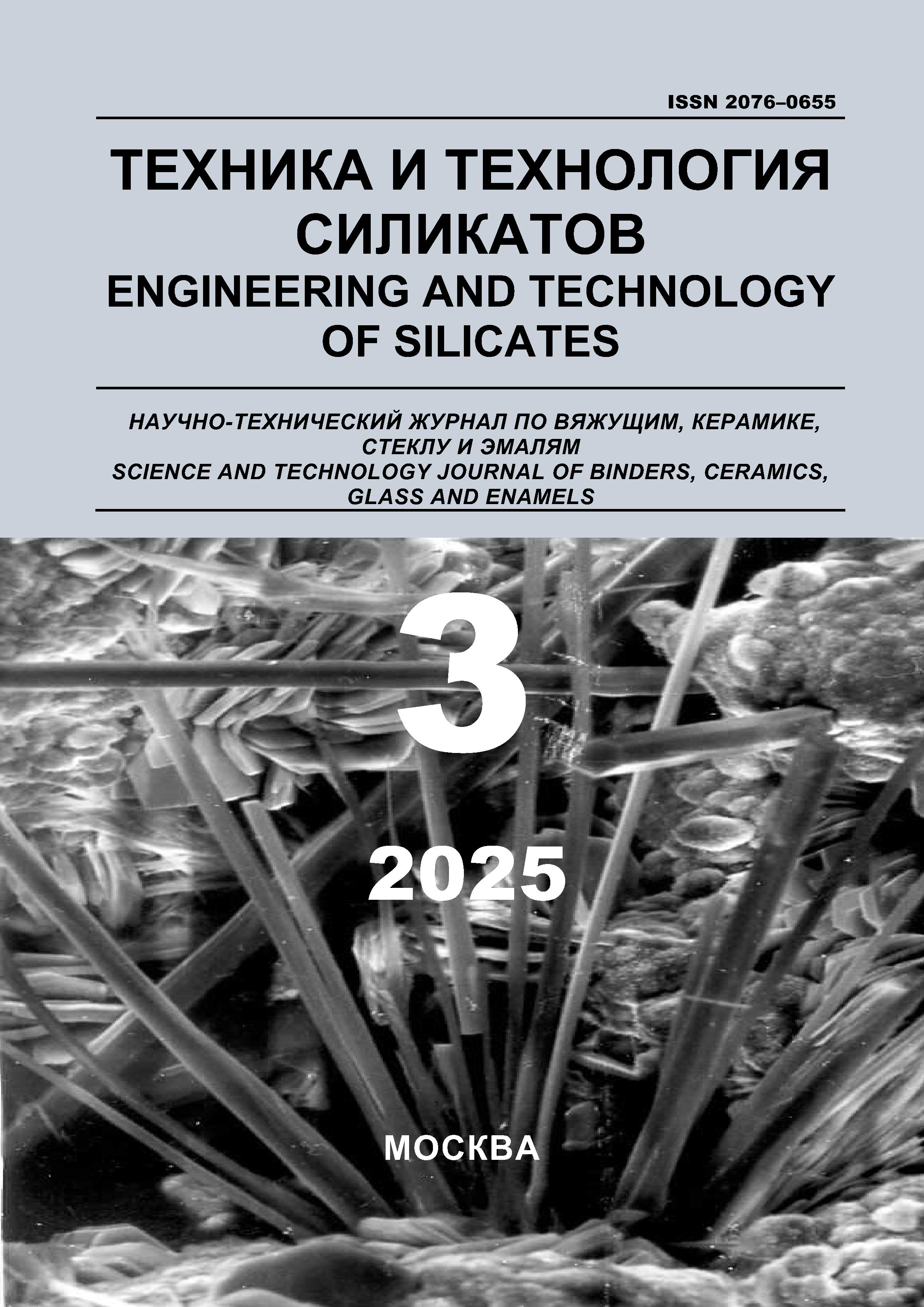UDC 691.32
CSCSTI 67.09
The article presents the analysis of modern techniques for the development of self-compacting concrete mixtures, which have become widespread in recent decades. The role of finely dispersed active and inert mineral additives of natural and artificial origin used to increase flowability and reduce bleeding of self-compacting concrete mixtures is shown. It has been established that the use of mineral additives makes it possible to fill the intergranular space of Portland cement clinker, increase the density of concrete and the degree of hydration of the binder. The mechanism of action of a complex chemical additive based on polycarboxylate esters, defoamers and an air-entraining component is given. It is shown that the introduction of plasticizing additives into the composition of any concrete mixtures leads to significant air entrain-ment, which is especially evident in the presence of polycarboxylate esters. The reduction of air entrainment is achieved by the introduction of defoamers, which contribute not only to the removal of entrained air, but also lead to an increase in the flowability of the concrete mixture and a decrease in plasticizer consumption. The presence of air-entraining additives leads not only to the formation of a significant amount of emulsified air in the system, preventing the destruction of air bubbles and being a source of formation of conditionally closed pores that act as a "reserve" in concrete, but also stabilizes the properties of concrete mixtures, which is manifested in reducing segregation and maintaining their coherent structure.
self-compacting concrete, flowability of self-compacting concrete mixtures, bleeding, complex chemical additive, polycarboxylate ethers, defoamer, air-entraining component, structure of self-compacting concrete, porosity.
1. Sonebi M., Yahia A. Mix design procedure, tests, and stand-ards. In book: Self-Compacting Concrete: Materials, Properties, and Applications. - 2020. - Pp. 1-30. https://doi.org/10.1016/B978-0-12-817369-5.00001-5.
2. Concrete Modification for Hot Weather Using Crushed Dolo-mite Stone / S. V. Samchenko, O. A. Larsen, I. V. Kozlova [et al.] // Buildings. – 2023. – Vol. 13, No. 10. – P. 2462. – https://doi.org/10.3390/buildings13102462 – EDN MGPLFU.
3. Samchenko S.V., Aleksandrova O.V., Gurkin A.Yu. Svoystva cementnyh kompozitov na osnove izvestnyaka v zavisimosti ot ego granulometricheskogo sostava // Vestnik MGSU. - 2020. - №15. - S. 999-1006.
4. Samouplotnyayuschiysya beton s kompensirovannoy usadkoy c ispol'zovaniem materialov iz betonnogo loma / S. V. Sam-chenko, V. V. Voronin, O. A. Larsen, V. V. Narut' // Izvestiya vysshih uchebnyh zavedeniy. Stroitel'stvo. – 2021. – № 2(746). – S. 71-78. – https://doi.org/10.32683/0536-1052-2021-746-2-71-78 – EDN EYNTLL.
5. Larsen O.A., Solodov A.A., Narut' V.V., Butenko K.A., Veselov V.K. Issledovanie svoĭstv tonkodispersnyh materi-alov dlya polucheniya samouplotnyayuschegosya betona // Tehnika i tehnologiya silikatov. - 2022. - T. 29. - № 4. S. 359 – 368.
6. Pera J., Husson S., Guilhot B. Influence of finely ground lime-stone on cement hydration // Cement and Concrete Composites. - 1999. - Vol. 21. - Pp. 99–105.
7. Balakrishnan S.D., Paulose K.C. Workability and strength char-acteristics of self-compacting concrete containing fly ash and dolomite powder. American Journal Engineering Research. - 2013. - Vol. 24. - Pp. 43–47.
8. Lothenbach B., Le Saout G., Gallucci E., Scrivener K. Influence of limestone on the hydration of Portland cements // Cement and Concrete Research. - 2008. - №38. - Pp. 848–860.
9. Larsen O.A., Solodov A.A., Bahrah A.M. Issledovanie vliyaniya penogasiteley na osnovnye svoystva plastificiro-vannogo cementnogo testa // Stroitel'nye materialy. - 2025. - № 3. - S. 74–81. https://doi.org/10.31659/0585-430X-2025-833-3-74-81
10. Ibrahim, R., Ahmad, S., Ghazal, A., Al-kroom, H. and Elrah-man, M. (2025) Studying the role of fine materials characteristics on the packing density and rheological properties of blended ce-ment pastes. Applied Rheology. - Vol. 35 (Issue 1). - Pp. 20250035. https://doi.org/10.1515/arh-2025-0035
11. Kosmatka S., Wilson M. Design and Control of Concrete Mix-tures. The Portland Cement Association, Scokie, Illinois, USA. 2016.
12. Larsen O., Samchenko S., Naruts V. Blended binder based on Portland cement and recycled concrete powder // Magazine of Civil Engineering. - 2022. - 113(5). - Article No. 11305
13. Kalmakova P.S., Larsen O.A. Vliyanie mikronapolnitelya na osnove vulkanicheskogo tufa na osnovnye svoystva smeshan-nogo vyazhuschego. V sbornike: Aktual'nye problemy stroi-tel'noy otrasli i obrazovaniya - 2024. Sbornik dokladov V Nacional'noy nauchnoy konferencii. Moskva. - 2025. - S. 181-186.
14. Larsen O.A., Samchenko S.V., Zemskova O.V., Korshunov A.V., Solodov A.A. Self-Compacting Mixtures of Fair-Faced Concrete Based on GGBFS and a Multicomponent Chemical Ad-mixture Technological and Rheological Properties. Buildings. - 2024, 14,3545.
15. Rekomendacii po podboru sostavov betonnyh smeseĭ dlya tyazhelyh i melkozernistyh betonov. Metodicheskoe posobie. NIIZhB im. A. A. Gvozdeva AO «NIC «Stroitel'stvo». Moskva. - 2016. - S. 100.
16. Samchenko, S. V. Vliyanie dispersnosti shlakovogo kompo-nenta na svoystva shlakoportlandcementa / S. V. Samchenko, O. V. Zemskova, I. V. Kozlova // Tehnika i tehnologiya silikatov. – 2016. – T. 23, № 2. – S. 19-23. – EDN WAOLWF.
17. Tsivilis S., Chaniotakis E., Badogiannis E., Pahoulas G., Ilias A. A study on the parameters affecting the properties of Portland limestone cements // Cement and Concrete Composites. - 1999. - № 21. - Pp. 107-116.
18. Moosberg-Bustnes H., Lagerblad B., Forssberg E. The func-tion of fillers in concrete // Materials and Structures. - 2004. - Vol. 37. - Pp 74-81.
19. Ahverdov I. N. Osnovy fiziki betona. Moskva: Stroyiz-dat, 1981. - 464 s.
20. Larsen O.A., Voronin V.V., Samchenko S.V. Kriterii ocenki strukturno-tehnologicheskih harakteristik betona // Tehnika i tehnologiya silikatov. - 2023. - T. 30, No 2. - S. 129-143.
21. Plank J., Sakai E., Miao C.W., Yu C., Hong J.X. Chemical admixtures — Chemistry, applications and their impact on concrete microstructure and durability // Cement and Concrete Research. 2015. – Vol. 78. Pp. 81–99.
22. Gelardi G., Mantellato S., Marchon D., Palacios M., Eberhardt A. B., Flatt, R. J. Chemistry of Chemical Admixtures. Science and Technology of Concrete Admixtures. 2016. Woodhead Publishing, Cambridge, 149-218.
23. Batrakov V. G. Modificirovannye betony. Teoriya i prak-tika. Moskva, 1998. - 768 s.
24. Zhang Y., Kong X. Correlations of the dispersing capability of NSF and PCE types of superplasticizer and their impacts on ce-ment hydration with the adsorption in fresh cement pastes // Ce-ment and Concrete Research. - 2015. - Vol. 69. - Pp. 1-9.
25. Sakai E., Kasuga T., Sugiyama T. et al. Influence of superplas-ticizers on the hydration of cement and the pore structure of hardened cement // Cement and Concrete Research. - 2006. - Vol.36 (11). - Pp. 2049-2053.
26. Rath S., Ouchi M. Effective Mixing Method for Stability of Air Content in Fresh Mortar of Self-Compacting Concrete in Terms of Air Diameter // Internet Journal for Society for Social Management Systems. - 2015. - Is. 10, Vol. 1. - Pp. 15-6550.
27. Lazniewska-Piekarczyk B. Influence of anti-foaming admixture and polycarboxylic superplasticizer type on fresh and hardened properties of self-compacting mortar // Architecture civil engineer-ing environment, The Silesian University of Technology - 2010. - No. 4. - Pp. 61-71.
28. Stol'nikov V. V., R. E. Litvinova. Treschinostoykost' betona. Moskva: Energiya, 1972. - 113 s.
29. Kuncevich O. V. Betony vysokoy morozostoykosti dlya sooruzheniy Kraynego Severa. Leningrad: Stroyizdat: Le-ningr. otdelenie, 1983. - 131 s.
30. Powers T.C., Helmuth R.A. Theory of volume changes in hardened cement paste during freezing, Highw. Res. Board Proc. - 1953. - Vol. 32. - Pp. 285–297.
31. Rebinder P. A. Poverhnostno-aktivnye veschestva. Moskva: Znanie, 1961. - 46 s.
32. Stol'nikov V. V. Vozduhovovlekayuschie dobavki v gidro-tehnicheskom betone. Leningrad: Gosenergoizdat, 1953. - 168 s.
33. Du L., Folliard K.J. Mechanisms of air entrainment in concrete // Cement and Concrete Research. - 2005. - Vol. 35. - Pp. 1463–1471.
34. Tunstall L. E., Tyler Ley M., Scherer G. W. Air entraining admixtures: Mechanisms, evaluations, and interactions // Cement and Concrete Research. - 2021. - Vol. 150. - P. 106557.









